The Firebird
The Firebird (French: L'Oiseau de feu; Russian: Жар-птица, romanized: Zhar-ptitsa) is a ballet and orchestral concert work by the Russian composer Igor Stravinsky. It was written for the 1910 Paris season of Sergei Diaghilev's Ballets Russes company; the original choreography was by Michel Fokine, with a scenario by Alexandre Benois and Fokine based on the Russian fairy tales of the Firebird and the blessing and curse it possesses for its owner. When first performed at the Opéra de Paris on 25 June 1910, the work was an instant success with both audience and critics.
| L'Oiseau de feu The Firebird | |
|---|---|
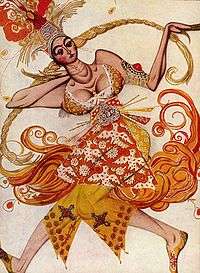 Léon Bakst: Firebird, Ballerina, 1910 | |
| Choreographer | Michel Fokine |
| Music | Igor Stravinsky |
| Based on | Russian folk tales |
| Premiere | 25 June 1910 Paris Opera |
| Original ballet company | Ballets Russes |
| Characters | The Firebird Prince Ivan Tsarevich Koschei, the Immortal The Beautiful Tsarevna |
| Design | Aleksandr Golovin (sets) Léon Bakst (costumes) |
| Created for | Tamara Karsavina, Michel Fokine |
The ballet has historic significance not only as Stravinsky's breakthrough piece, but also as the beginning of the collaboration between Diaghilev and Stravinsky that would also produce the acclaimed ballets Petrushka (1911) and The Rite of Spring (1913).
History
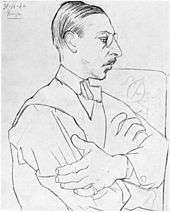
Background
Igor Stravinsky was the son of Fyodor Stravinsky, the principal bass at the Imperial Opera, St Petersburg, and Anna, née Kholodovskaya, a competent amateur singer and pianist from an old-established Russian family. Fyodor's association with many of the leading figures in Russian music, including Rimsky-Korsakov, Borodin and Mussorgsky, meant that Igor grew up in an intensely musical home.[1] In 1901, Stravinsky began to study law at St Petersburg University, while taking private lessons in harmony and counterpoint. Having impressed Rimsky-Korsakov with some of his early compositional efforts, Stravinsky worked under the guidance of the older composer. By the time of his mentor's death in 1908, Stravinsky had produced several works, among them a Piano Sonata in F♯ minor (1903–04), a Symphony in E♭ major (1907), which he catalogued as "Opus 1", and in 1908 a short orchestral piece, Feu d'artifice ("Fireworks").[2][3]
In 1909, Feu d'artifice was performed at a concert in St Petersburg. Among those in the audience was the impresario Sergei Diaghilev, who at that time was planning to introduce Russian music and art to western audiences.[4] Like Stravinsky, Diaghilev had initially studied law, but had gravitated via journalism into the theatrical world.[5] In 1907, he began his theatrical career by presenting five concerts in Paris; in the following year, he introduced Mussorgsky's opera Boris Godunov. In 1909, still in Paris, the Ballets Russes was launched, initially with Borodin's Polovtsian Dances from Prince Igor and Rimsky-Korsakov's Scheherazade. To present these works, Diaghilev recruited the choreographer Michel Fokine, the designer Léon Bakst and the dancer Vaslav Nijinsky. Diaghilev's intention, however, was to produce new works in a distinctively 20th-century style, and he was looking for fresh compositional talent.[6]
Creation
The ballet was the first of Sergei Diaghilev's Ballets Russes productions to have an all-original score composed for it. Alexandre Benois wrote in 1910 that he had two years earlier suggested to Diaghilev the production of a Russian nationalist ballet,[7] an idea all the more attractive given both the newly awakened French passion for Russian dance and also the ruinously expensive costs of staging opera. The inspiration of mixing the mythical Firebird with the unrelated Russian tale of Koschei the Deathless possibly came from a popular child's verse by Yakov Polonsky, "A Winter's Journey" (Zimniy put, 1844), which includes the lines:
And in my dreams I see myself on a wolf's back
Riding along a forest path
To do battle with a sorcerer-tsar (Koschei)
In that land where a princess sits under lock and key,
Pining behind massive walls.
There gardens surround a palace all of glass;
There Firebirds sing by night
And peck at golden fruit.[8]
Benois collaborated with the choreographer Michel Fokine, drawing from several books of Russian fairy tales including the collection of Alexander Afanasyev, to concoct a story involving the Firebird and the evil magician Koschei.
Diaghilev approached the Russian composer Anatoly Lyadov (1855–1914) to write the music.[9] There is no evidence, however, despite the much-repeated story that Lyadov was slow to start composing the work, that he ever accepted the commission to begin with.[10] There is evidence to suggest that Nikolai Tcherepnin had previously started composing music for the ballet—music which became The Enchanted Kingdom—but that Tcherepnin, for reasons unexplained, withdrew from the project after completing only one scene.[11] Diaghilev eventually transferred the commission to the 28-year-old Stravinsky.
Impact
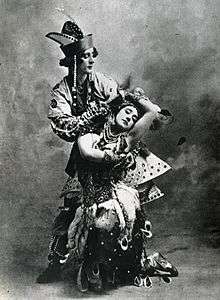
The ballet was premiered by the Ballets Russes at the Palais Garnier in Paris on 25 June 1910, conducted by Gabriel Pierné.[12] Even before the first performance, the company sensed a huge success in the making, and every performance of the ballet in that first production, as Karsavina recalled, met a "crescendo" of success.[13] The critics were ecstatic, praising the ballet for what they saw as an ideal symbiosis among decor, choreography and music: "The old-gold vermiculation of the fantastic back-cloth seems to have been invented to a formula identical with that of the shimmering web of the orchestra" enthused Henri Ghéon in Nouvelle revue française (1910).[13] The scenery was designed by Alexander Golovine and the costumes by Léon Bakst.
For Stravinsky, it was a major breakthrough both with the public and with the critics, Michel-Dimitri Calvocoressi in particular hailing Stravinsky as the legitimate heir to The Mighty Handful.[14] The Firebird's success also secured Stravinsky's position as Diaghilev's star composer, and there were immediate talks of a sequel,[15] leading to the composition of Petrushka and The Rite of Spring. "Mark him well—said Sergei Diaghilev to Tamara Karsavina, who was dancing the title role—he is a man on the eve of celebrity ..."[16]
Stravinsky used several ideas from works by Rimsky-Korsakov in his score. Koschei's "Infernal Dance" borrows the highly chromatic scale Rimsky-Korsakov created for the character Chernobog in his opera Mlada. The Khorovod, meanwhile, uses the same folk tune Rimsky-Korsakov presented in his Sinfonietta, Op. 31.
Russian composer Sergei Rachmaninoff was a fan of the work. Upon listening to the ending, his friend Sergei Bertensson recalled the composer saying: "Great God! What a work of genius this is! This is true Russia!"[17]
Subsequent ballet performances
%2C_Ballets_Russes%2C_Sydney.jpg)
The Firebird has been restaged by many choreographers, including George Balanchine and Jerome Robbins (co-choreographers), Graeme Murphy, Alexei Ratmansky, and Yuri Possokhov.
The ballet was revived in 1934 by Colonel Wassily de Basil's company, the Ballets Russes de Monte-Carlo, in a production staged in London, using the original decor and costumes from Diaghilev's company.[18] The company subsequently performed the ballet in Australia, during the 1936–37 tour.[19]
The work was staged by George Balanchine for the New York City Ballet in 1949 with Maria Tallchief as the Firebird, with scenery and costumes by Marc Chagall, and was kept in the repertory until 1965. The ballet was restaged by George Balanchine and Jerome Robbins in 1970 for the New York City Ballet with elaborated scenery by Chagall, and with new costumes by Karinska based on Chagall's for the 1972 Stravinsky Festival that introduced Gelsey Kirkland as the Firebird.[20]
In 1970 Maurice Béjart staged his own version in which the ballet's protagonist was a young man who rose from the ranks of the revolutionists and became their leader. The lead role was danced by Michel Denard.[21]
The Mariinsky Ballet performed the original choreography at Covent Garden in August 2011, as part of their Fokine retrospective.[22]
The National Ballet of Canada created a version of the Firebird for television, occasionally rebroadcast, in which special effects were used to make it appear that the Firebird is in flight.
On 29 March 2012, the American Ballet Theatre premiered the ballet with choreography by Alexei Ratmansky at the Segerstrom Center for the Arts in Costa Mesa, California, starring Misty Copeland.
The Royal Ballet staged 6 performances of the ballet at the Royal Opera House in London in June 2019, with Yasmine Naghdi performing the role of the Firebird.[23][24]
Synopsis
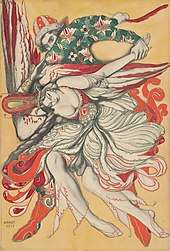
The ballet centers on the journey of its hero, Prince Ivan. While hunting in the forest, he strays into the magical realm of Koschei the Immortal, whose immortality is preserved by keeping his soul in a magic egg hidden in a casket. Ivan chases and captures the Firebird and is about to kill her; she begs for her life and he spares her. As a token of thanks, she offers him an enchanted feather that he can use to summon her should he be in dire need.
Prince Ivan then meets thirteen princesses who are under the spell of Koschei and falls in love with one of them. The next day, Ivan confronts the magician and eventually they begin quarrelling. When Koschei sends his minions after Ivan, he summons the Firebird. She intervenes, bewitching the monsters and making them dance an elaborate, energetic dance (the "Infernal Dance").
The creatures and Koschei then fall into a deep sleep. While they sleep, the Firebird directs Ivan to a tree stump where the casket with the egg containing Koschei's soul is hidden. Ivan destroys the egg and with the spell broken, the magical creatures that Koschei held captive are freed and the palace disappears. All of the "real" beings, including the princesses, awaken and with one final hint of the Firebird's music (though in Fokine's choreography she makes no appearance in that final scene on-stage), celebrate their victory.
Music
|
|
Instrumentation
The work is scored for a large orchestra with the following instrumentation:[25]
|
|
Ballet suites
.jpg)
Besides the complete 50-minute ballet score of 1909–10, there are three shorter suites arranged by the composer himself for concert performance which date from 1911, 1919, and 1945. The 1911 suite retains the original orchestration, while the 1919 and 1945 suites are scored for smaller orchestras. While the 1919 suite remains the most well known[27][28] and often played, the 1945 version contains the most music from the original ballet score (partly motivated by the need to secure copyright in a USA that did not recognize European agreements).
There is no consensus for the precise naming of either the different versions, or of the movements, or the numbering of the movements. Different recordings tend to follow different naming conventions. While this may partly be due to the English translation from the original French names, some recordings of the orchestral suites even avoid referring to the tale by just calling the movements by their tempo markings (i.e., Adagio, Allegro, etc.) or the name of the musical form (Scherzo, Rondo, etc.).
Many adaptations of The Firebird Suite for concert band, marching band and drum corps have been made throughout the years.
1911 Suite
- "Concert Suite for Orchestra No. 1"
- Introduction – Kashchei's Enchanted Garden – Dance of the Firebird
- Supplication of the Firebird
- The Princesses’ Game with Apples
- The Princesses’ Khorovod (Rondo, round dance)
- Infernal Dance of all Kashchei's Subjects[29]
Instrumentation: essentially as per the original ballet[27]—the score was printed from the same plates, with only the new endings for the movements being newly engraved.
Some recordings list the first movement as three movements.
The suite is sometimes referred to as the "Symphonic Suite"[27] In 1928, Stravinsky conducted a group of Parisian musicians in a recording of this suite for Columbia Records, which was released on a set of 12-inch 78-rpm discs. The Kalmus orchestral score for this suite is dated "1910", while Luck's Music publishes this version as "1912". The 2005 remastered edition on Sony with conductor Pierre Boulez calls it "Ballet suite for orchestra", while in 1991 Sony called it "Suite, 1910".
1919 Suite
- "Concert Suite for Orchestra No. 2"
- Introduction – The Firebird and its dance – The Firebird's variation
- The Princesses’ Khorovod (Rondo, round dance)
- Infernal dance of King Kashchei
- Berceuse (Lullaby)
- Finale
Instrumentation: 2 flutes (2nd also piccolo); 2 oboes (2nd also English horn for one measure); 2 clarinets; 2 bassoons; 4 horns; 2 trumpets; 3 trombones; tuba; timpani; bass drum; cymbals; triangle; xylophone; harp; piano (also opt. celesta); strings.[30]
This suite was created in Switzerland for conductor Ernest Ansermet.[28] When it was originally published, the score contained many mistakes, which were only fixed in 1985.[27]
Some recordings will list movement no. 1 as two or three movements.
1945 Suite
- "Ballet Suite for Orchestra"
- Introduction – The Firebird and its dance – The Firebird's variation
- Pantomime I
- Pas de deux: Firebird and Ivan Tsarevich
- Pantomime II
- Scherzo: Dance of the Princesses
- Pantomime III
- The Princesses' Khorovod (Rondo, round dance)
- Infernal dance of King Kashchei
- Berceuse (Lullaby)
- Finale
Instrumentation: 2 Flutes (2nd also Piccolo); 2 Oboes; 2 Clarinets; 2 Bassoons; 4 Horns; 2 Trumpets; 3 Trombones; Tuba; Timpani; Bass Drum; Snare Drum; Tambourine; Cymbals; Triangle; Xylophone; Harp; Piano; Strings.
In addition to adding more movements, Stravinsky made revisions to notation, barring, and meter in order to facilitate reading. He also made a number of changes in orchestration.[31]
Once again, some recordings will list movement no. 1 as three movements.
Stravinsky recorded this suite in 1967, his last commercial recording for Columbia Records.
In popular culture
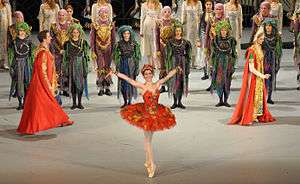
The Princesses' Khorovod and The Infernal Dance of King Katscheï were used in Bruno Bozzetto's animated film Allegro Non Troppo. The segment visualizes a variant of the Adam and Eve story.[32] However, in this version, both Adam and Eve refuse to eat the apple offered by the Serpent, who then swallows it himself. Falling asleep, he is immediately plunged into a nightmare where he is first tormented by fiery demons and then plagued by things that are supposed to corrupt mankind (sex, alcohol, money, material objects, drugs, violence); he also somehow grows arms and legs and is magicked into a suit and fedora. When he wakes up, he is still wearing the suit and hat; after telling Adam and Eve his dream in a fast-motion and incomprehensible fashion, he sheds the suit (losing his arms and legs but keeping the hat) and spits up the still-whole apple.
The chapter in the animated film Fantasia 2000 based on Stravinsky's piece uses an abridged version of the 1919 suite (mostly evidenced by a shortened Infernal Dance) to tell the story of the Spring Sprite and her companion, an elk. After a long winter, the Sprite is brought forth by the Elk and attempts to restore life to a forest but accidentally wakes the "Firebird" spirit of a nearby volcano. Angered, the Firebird proceeds to destroy the forest and seemingly the Sprite. She survives, but is initially despondent. With the Elk to comfort her, she quickly regains her confidence and restores the forest to its prior glory. The Fantasia 2000 Firebird chapter is considered an exercise in the theme of life-death-rebirth deities; the depiction of the Firebird in it as a violent, flaming volcanic spirit is not related to Stravinsky's original theme.
Saviour Pirotta and Catherine Hyde's picture book, Firebird, is based on the original stories that inspired the ballet. It was published by Templar in the UK and Candlewick Press in 2010 to celebrate the ballet's centenary. It won an Aesop Accolade in the US and was nominated for the Kate Greenaway Award in the UK. The paperback was published in 2014.[33]
Stravinsky was a major influence in popular and erudite United States composer Frank Zappa and the melody for Berceuse can be heard in his 1967 album Absolutely Free, in the Amnesia Vivace section of the "Duke of Prunes" suite (along with a melody from The Rite of Spring).[34][35]
The chord that opens the Infernal Dance section has become a widely used orchestra hit sample in music throughout the 1980s and 1990s, specifically within new jack swing.[36]
The ending section of the ballet is closely associated with the progressive rock band Yes, who has regularly used it as their "walk-on" music in concert since 1971.
It was used in the opening ceremony of Sochi 2014 during the Cauldron Lighting segment.[37]
Selected recorded versions
Complete ballet
Notable recordings of the complete ballet include:
Year Orchestra Conductor Record Company Format Notes 1959 London Symphony Orchestra Antal Doráti Mercury Records CD 1961 Columbia Symphony Orchestra Igor Stravinsky Columbia Masterworks CD / LP 1968 New Philharmonia Orchestra Ernest Ansermet Decca CD / LP 1978 Royal Concertgebouw Orchestra Colin Davis Philips CD [38] 1982 Royal Danish Orchestra Paul Jorgensen Kultur DVD [39] 1982 Detroit Symphony Orchestra Antal Doráti Decca Records CD 1984 Montreal Symphony Orchestra Charles Dutoit Decca Records CD 1992 Seattle Symphony Orchestra Gerard Schwarz Delos Records CD [40] 1993 Chicago Symphony Orchestra Pierre Boulez Deutsche Grammophon CD [41] 1998 Kirov Orchestra Valeri Gergiev Philips Classics Records CD 1996 Philharmonia Orchestra Robert Craft Koch Records / Naxos Records CD [42] 1972 Orchestre de Paris Seiji Ozawa EMI CD 1998 San Francisco Symphony Orchestra Michael Tilson Thomas RCA CD [43][44] 2008 City of Birmingham Symphony Orchestra Simon Rattle EMI CD 2008 Los Angeles Philharmonic Orchestra Esa-Pekka Salonen Deutsche Grammophon Download [45][46]
Firebird Suite
- Leopold Stokowski recorded The Firebird Suite eight times, more than any other conductor: with the Philadelphia Orchestra (acoustically) in 1924, and again (electrically) in 1927 and 1935; with the All-American Youth Orchestra in 1941 and the NBC Symphony Orchestra in 1942; with his own Symphony Orchestra in 1950; and in two stereo recordings, with the Berlin Philharmonic in 1957, and finally, at the age of 85, with the London Symphony Orchestra in 1967.
- Leonard Bernstein recorded the suite with the New York Philharmonic for Columbia Masterworks (now Sony Masterworks) in 1957, and again with the Israel Philharmonic for Deutsche Grammophon in 1984. Bernstein's first version also includes Rimsky-Korsakov's Scheherazade on the CD release. Bernstein's second recording of the piece is included on a CD-set entitled Bernstein Conducts Stravinsky.
- Pierre Monteux conducting the Paris Conservatoire Orchestra (released on Decca Records in 1972 as STS 15197; the disc also includes the complete Petrushka ballet).
- Isao Tomita recorded his own synthesizer arrangement of The Firebird Suite on his 1976 album, Firebird.
- Claudio Abbado conducting the London Symphony Orchestra, 1919 version recorded in 1975 and released on Deutsche Grammophon
- Neeme Järvi conducting the London Symphony Orchestra, 1945 version recorded in 1988 and released on Chandos Records in 1989; also includes Nikolai Rimsky-Korsakov's Dubinushka, Op. 62 and Lyadov's Baba-Yaga op. 56, The Enchanted Lake Op. 62 and Kilimora Op. 63.
- Kazuhito Yamashita—arrangement for classical guitar (released on RCA Records in 1989; the disc also includes a classical guitar arrangement of Antonín Dvořák's Symphony No. 9).
- Ivan Fischer conducting the Budapest Festival Orchestra, 1919 version (released on Hungaroton in 1990 as HCD 31095, recorded in 1988; the disc also includes the complete Petrushka ballet, 1946–47 version).
- George Szell conducting the Cleveland Orchestra (released on Epic Records as LC 3812 and BC 1149; the disc also includes William Walton's Symphony No. 2).
- Robert Shaw conducting the Atlanta Symphony Orchestra (released on Telarc as CD-80039); the disc also includes [some of the] Music from Prince Igor, by Alexander Borodin.
- Gennady Rozhdestvensky conducting the Concertgebouw Orchestra (broadcast by the Radio Nederland Transcription Service on the Dutch Concert Rostrum, Program 8319; not commercially released; the program also includes Wolfgang Amadeus Mozart's Overture to The Marriage of Figaro (Rotterdam Philharmonic Orchestra/Jean Fournet) and Johannes Brahms's Variations on the Chorale St. Anthony, op. 56a (Concertgebouw Orchestra/Erich Leinsdorf)).
Excerpts from The Firebird Suite
- Berceuse: Lori Singer, solo-cello performance (included on the Short Cuts soundtrack)
- Danse Infernale: Igor Stravinsky conducting the Columbia Symphony Orchestra (released on Columbia Records as MS 7094; disc includes five other Stravinsky compositions)
- Firebird Suite (1919 version—excerpt): James Levine and the Chicago Symphony Orchestra. Included on the Fantasia 2000 soundtrack album.
Notes
- Citation notes
- Walsh, Stephen (2012). "Stravinsky, Igor, §1: Background and early years, 1882–1905". Grove Music Online. Retrieved 9 August 2012. (subscription required)
- Walsh, Stephen (2012). "Stravinsky, Igor, §2: Towards The Firebird, 1902–09". Grove Music Online. Retrieved 9 August 2012. (subscription required)
- "Stravinsky, Igor, §11: Posthumous reputation and legacy: Works". Grove Music Online. 2012. Retrieved 9 August 2012. (subscription required)
- White 1961, pp. 52–53
- "Diaghilev, Serge". The Oxford Dictionary of Music Online edition. 2012. Retrieved 9 August 2012. (subscription required)
- Griffiths, Paul (2012). "Diaghilev [Dyagilev], Sergey Pavlovich". Grove Music Online. Retrieved 9 August 2012. (subscription required)
- Benois' 1910 article: "Two years ago I gave voice … to the dream that a true 'Russian (or perhaps Slavonic) mythology' would make its appearance in ballet"; quoted in Taruskin 1996, p. 555
- Taruskin 1996, pp. 556–557.
- Taruskin 1996, pp. 576–577.
- Taruskin 1996, pp. 577–578.
- Taruskin 1996, pp. 574–575.
- Stephen Walsh: 'Stravinsky, Igor', Grove Music Online ed. L. Macy (Retrieved 1 April 2008)
- Taruskin 1996, p. 638.
- Taruskin 1996, p. 639.
- Taruskin 1996, p. 662.
- White, Eric Walter. "The Man," Stravinsky the Composer and his Works (University of California Press, 1969), p. 18.
- Slonimsky 2014, p. 197.
- Sorley Walker 1982, p. 41.
- "Ballets Russes | What's On". National Library of Australia. Retrieved 5 April 2011.
- The 1970 restaging uses only the 1945 suite as accompaniment, as indicated by a program note whenever the work is performed.
- Pitou, Spire (1990). The Paris Opera: An Encyclopedia of Operas, Ballets, Composers, and Performers; Growth and Grandeur, 1815-1914; M-Z. Greenwood Press. ISBN 978-0-313-27783-2.
- "Mariinsky in London Roundup". The Ballet Bag. 26 August 2011. Retrieved 18 June 2019.
- "The Firebird triple bill, Royal Ballet review – generous programme with Russian flavour". theartsdesk.com. Retrieved 18 June 2019.
- "A gorgeous triple bill to end The Royal Ballet's season". bachtrack.com. Retrieved 18 June 2019.
- Stravinsky, I. (1910). L'Oiseaux de Feu (conte dansé en 2 tableaux) [original ballet score]. Moscow: P. Jurgenson, 1911. Print.
- L'oiseau de feu: Ballet, 1934, OCLC 1043248229, retrieved 14 April 2020
- Kramer, Jonathan D. "Stravinksy's Firebird". cincinnatisymphony.org. Retrieved 27 November 2018.
- Dettmer, Roger. "L'oiseau de feu (The Firebird), concert suite for orchestra No. 2". AllMusic. Retrieved 27 November 2018.
- Johnston, Blair. "L'oiseau de feu (The Firebird), concert suite for orchestra No. 1". AllMusic. Retrieved 27 November 2018.
- IMSLP.
- Carpenter, Alexander. "L'oiseau de feu (The Firebird), ballet suite for orchestra". AllMusic. Retrieved 27 November 2018.
- Chris Hicks (12 March 1991). "Allegro Non Troppo". Deseret News. Retrieved 5 December 2011.
- "FIREBIRD". Catherine Hyde Home. Archived from the original on 26 August 2014. Retrieved 22 August 2014.
- Zappa, Frank (1989). The real Frank Zappa book. United States: Simon & Schuster. p. 167. ISBN 0-671-63870-X.
- Ulrich, Charles (2018). The Big Note. Canada: Star Books. p. 3. ISBN 9781554201464.
- "The fascinating history of the "orchestra hit" in music". kottke.org.
- "The XXII Olympic Winter Games in Sochi in 2014 has opened with a grand show thrilling spectators". Sochi Organizing Committee. 8 February 2014. Archived from the original on 8 February 2014.
- "L'oiseau de feu (The Firebird), ballet in 2 scenes for orchestra – Stravinsky: Ballets". Rovi Corporation. 2 August 1993. Retrieved 5 April 2011.
- Features the Royal Danish Ballet choreographed by Glen Tetley.
- Russian prima ballerina Natalia Makarova narrates the story. This recording won the 1991/1992 American Library Association Award.
- "Stravinsky Der Feuervogel Boulez – Catalogue". Deutsche Grammophon. 2 August 1993. Retrieved 5 April 2011.
- "Stravinsky, I.: Firebird (The) / Petrushka (Craft) (Stravinsky, Vol. 2)". Naxos. 2 August 1993. Retrieved 5 April 2011.
- This set won the 2000 Grammy Award for Best Orchestral Performance and the 2000 Grammy Award for Best Classical Album
- "L'oiseau de feu (The Firebird), ballet in 2 scenes for orchestra – Stravinsky: Le sacre du printemps; L'Oiseau de feu; Perséphone". Rovi Corporation. 2 August 1993. Retrieved 5 April 2011.
- This live recording is only available in CD. It was recorded in the Walt Disney Concert Hall.
- "L'oiseau de feu (The Firebird), ballet in 2 scenes for orchestra". Deutsche Grammophon. 2 August 1993. Retrieved 5 April 2011.]
References
- Slonimsky, Nicholas (2014). Slonimsky's Book of Musical Anecdotes. Hoboken: Taylor and Francis. ISBN 978-1-135-36860-9.CS1 maint: ref=harv (link)
- Sorley Walker, Kathrine (1982). De Basil's Ballets Russes. London: Hutchinson. ISBN 0-09-147510-4.CS1 maint: ref=harv (link) (New York, Atheneum. ISBN 0-689-11365-X)
- Taruskin, Richard (1996). Stravinsky and the Russian Traditions. Oxford: Oxford University Press. ISBN 0-19-816250-2.CS1 maint: ref=harv (link)
- The Firebird: Scores at the International Music Score Library Project (IMSLP)
External links
| Wikimedia Commons has media related to The Firebird. |